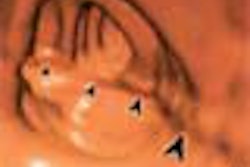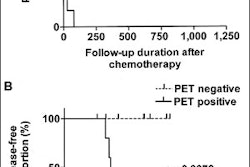Reassuring news in coronary calcium screening came out of Ohio State University in Columbus this month, where researchers have found that all of the principal calcium-scoring methods do a pretty good job of assessing the risk of coronary events.
In a paper comparing Agatston, volume, and mass scores in 11,490 individuals, radiologist and cardiovascular disease specialist Dr. John Rumberger and imaging consultant Leon Kaufman, Ph.D. report that with few exceptions, risk stratification seems to be "reasonably the same" regardless of which of the three major scoring methods is used. Nevertheless, the portability of the mass technique across protocols and technologies gives this relatively new method the edge, they concluded (American Journal of Roentgenolgy, September 2003, Vol. 181:3, pp. 743-748).
Researchers have demonstrated that the extent of coronary calcification is directly related to the incidents of coronary events, but an individual's actual calcium score may be less useful than his or her percentile ranking.
"Recent studies have emphasized that a calcium score above the 75th percentile for age and sex may increase heart risk an order of magnitude above that for individuals with scores below the 25th percentile," the authors wrote. "Thus, even small scores that are much higher than those anticipated for age and sex may be better predictors of risk."
In order to stratify the risk based on different scoring methods, the group compared calcium scores in their own cohort with those from a published database, known as the Kondos database, based on the Agatston scale, and comprised mostly of asymptomatic white middle and upper-middle class individuals (American Journal of Cardiology, June 15, 2001, Vol. 87:12, pp. 1335-1339).
Between 1999 and 2003, the Ohio group examined 11,490 patients (aged 25 to 84, 63% men) with an electron-beam scanner (Imatron, GE Medical Systems, South San Francisco, CA) using a slice thickness of 3 mm, spatial resolution of 1.4 mm full-width at half-maximum, 26-mm field of view, threshold of 130 Hounsfield units. Images were triggered prospectively at 60%-80% of the R-R interval. All results were measured with AccuScore (AccuImage Diagnostics, South San Francisco, CA).
Agatston scores were determined by calculating an area for all pixels above a threshold of 130 HU, repeated every 3 mm and multiplied by a weight, as used by Agatston et al (Journal of the American College of Cardiology, 1990; 15:827-832).
Volume scores were calculated by computing a volume above threshold, in the manner employed by Callister et al (Radiology, 1998; 208:807-814).
"Mass was calculated as an integral (sum) of all Hounsfield values in a lesion multiplied by the voxel volume in millimeters cubed," the authors wrote. A scaling factor of 1100/HU/mg was chosen to yield a mass that approximately represents bone ash equivalent.
According to the results, the group found "substantial equivalence for men and women, except at the youngest and oldest ranges, in which we showed lower and higher values, respectively. This could have been due to our using a broader age range (than the Kondos database) so that more younger people were included (this reduced the average score for the young) and more older individuals at the high age end (this increased the average score)."
As for differences in risk stratification among the different scoring methods, 35 of 1,079 men ages 50-54 were misclassified above or below the 50th percentile mark between Agatston and mass scores; 23 were misclassified between volume and mass scores. Just one woman 70-74 years old was misclassified around the 50th percentile mark. Average variability was 38%, and about half the cases could be reproduced with 25% variability or less, they wrote, adding that the findings were consistent with those in the literature.
"Thus, under the conditions of this study, neither method recommends itself as superior to another for stratification of reproducibility on a patient-by-patient basis," the group wrote. "We do not mean to imply that the volume and mass methods simply differ by a scale factor: The ratio (a pseudodensity) varies from 0.0057 mg/mm3 to 1.14 mg/mm3 (a dynamic range of 20), with 78% in the 0.2-0.3 mg/mm3 range. We call this a pseudodensity because the volume score overestimates true volume so that the ratio underestimates density. The largest value should be 1.44 mg/mm3, pure bone ash, and none of the measured values exceeds it."
The mass method has one advantage over the other methods in its superior reflection of the physical properties of the lesion, they wrote, making the mass method better adapted to portability between the different types of CT scanners, including 13 spiral, MDCT and electron-beam units, from different manufacturers the group tested.
"Two effects can be noted: For lesions under 10 mm3 in volume, the mass method is more closely reflective of the lesion volume, and the spread of values between the two scanners is much less for the mass method," they wrote. "For the lower-resolution scanner, the peak intensity of the signal from the small wire fell below 130 HU and was not scored. Operating with a lower threshold (which is possible in the newer scanners) significantly improves the mass method measurements but paradoxically worsens the results from the volume method."
Since different scanner types and rapid technological evolution are realities in today's market, the mass method is the best adapted for comparison among different scanners, Rumberger and Kaufman wrote. "As the methodology changes, it is desirable to have a measurement method that can grow with it."
By Eric BarnesAuntMinnie.com staff writer
September 10, 2003
Related Reading
Coronary calcium scan gains ground as prognostic tool, August 6, 2003
Study finds blacks have less coronary calcium than whites, February 17, 2003
Thin-collimation MDCT identifies more coronary calcium, December 18, 2002
Population-based study links coronary calcium and mortality, December 1, 2002
Technology keeps CT vital for coronary assessment, November 13, 2002
CT calcium scoring works, but what does it mean?, January 8, 2002
Copyright © 2003 AuntMinnie.com




















